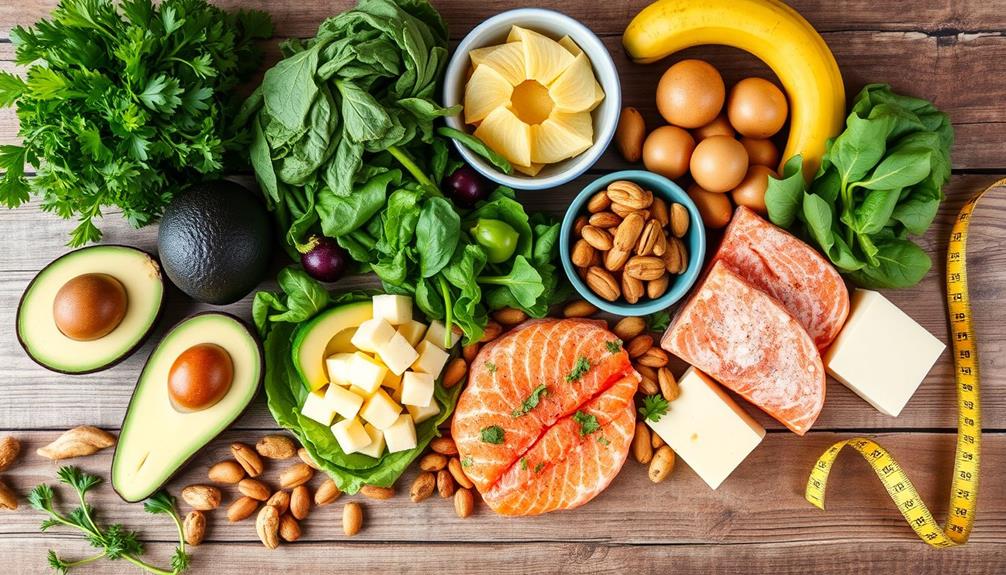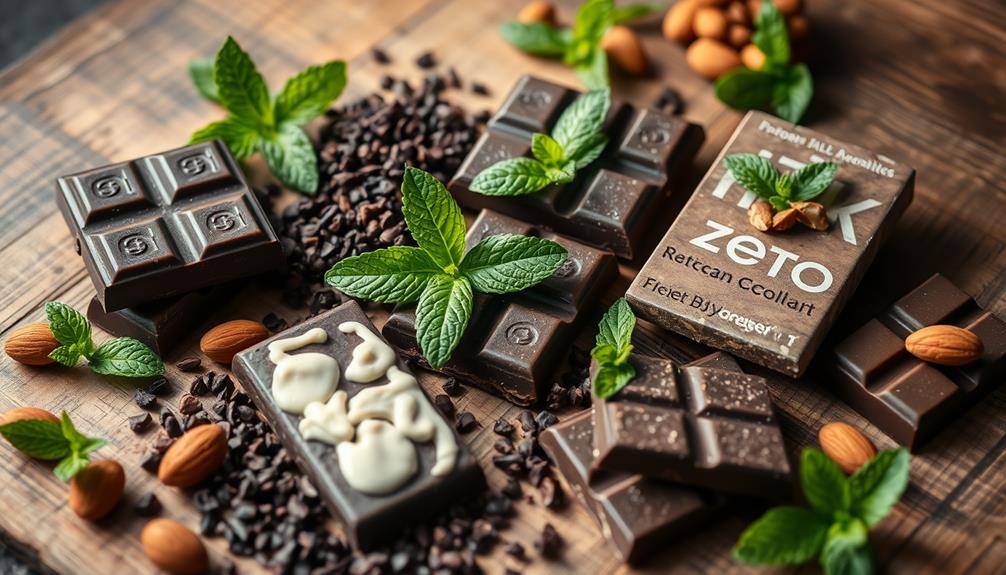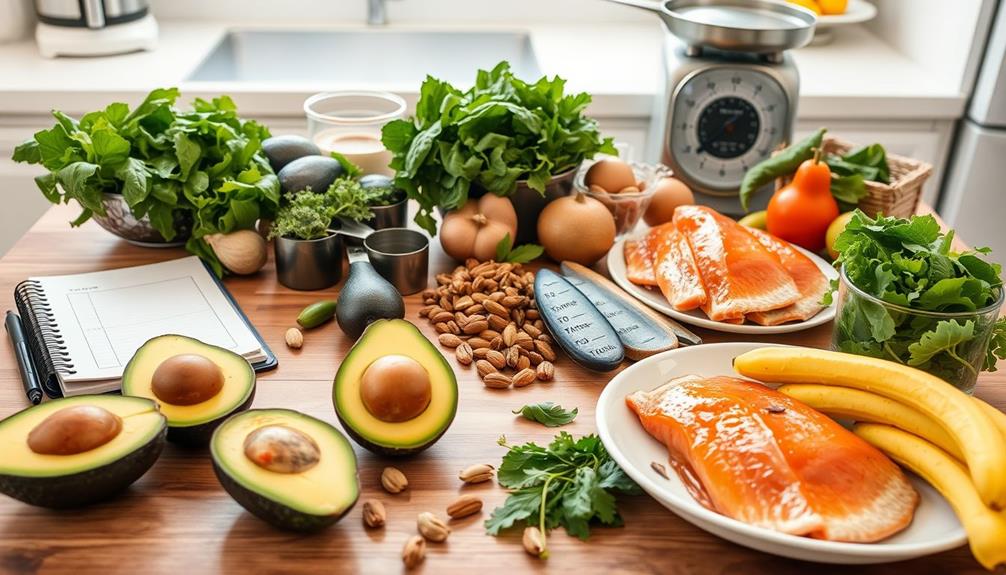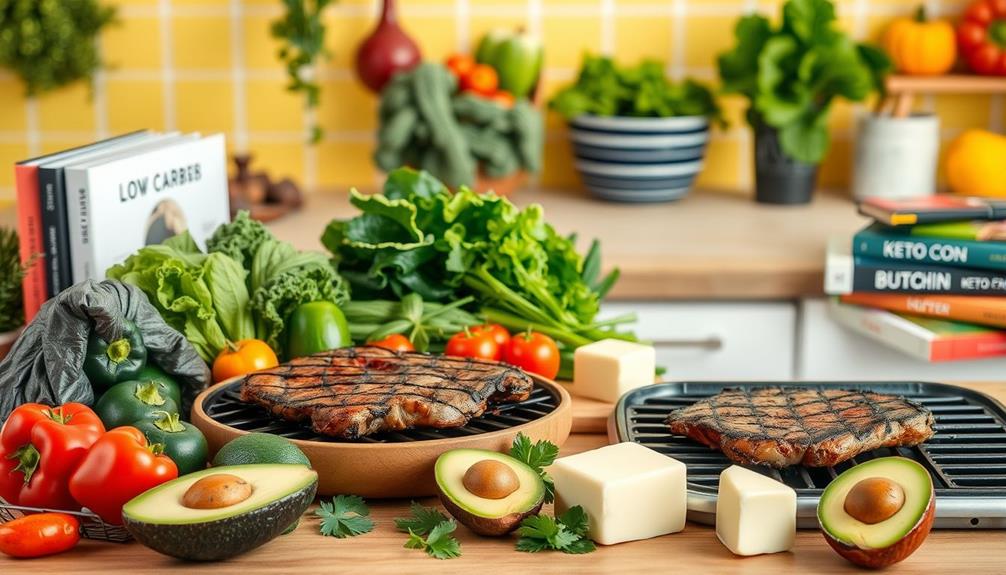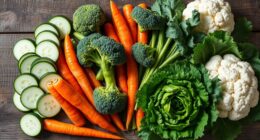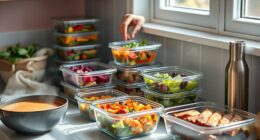To design a keto diet, you'll need to focus on a macronutrient ratio of 70-75% fats, 20-25% protein, and only 5-10% carbohydrates. Limit your carb intake to under 50 grams per day to induce ketosis, where your body burns fat for fuel. Include healthy fats like avocados and olive oil, and choose protein sources like grass-fed beef or fatty fish. Avoid high-carb foods, such as bread and sugary snacks. Meal planning and prep are essential to stay on track. There's much more to explore about crafting your keto lifestyle, so keep going for additional insights! When planning your meals, it’s important to understand the keto diet breakdown and how it applies to the foods you consume. This involves carefully selecting foods that fit into the appropriate macronutrient ratio, which can be challenging but is essential for success on the keto diet. Additionally, tracking your daily intake of fats, proteins, and carbohydrates can help ensure you’re staying within the recommended ranges for each category.
Key Takeaways
- Focus on a macronutrient ratio of 70-75% fats, 20-25% protein, and 5-10% carbohydrates, limiting carbs to under 50 grams daily.
- Include healthy fats like avocados and olive oil, protein sources such as grass-fed beef and fatty fish, and low-carb vegetables.
- Avoid high-carb foods like bread, pasta, sugary snacks, and starchy vegetables, along with most fruits.
- Plan meals ahead using batch cooking and create a shopping list to streamline your grocery shopping.
- Stay hydrated and consider electrolyte-rich foods to manage symptoms of "keto flu" during the initial adjustment phase.
Understanding the Keto Diet

Understanding the principles of the ketogenic diet can be empowering as you commence on this low-carb journey. The keto diet focuses on a specific macronutrient ratio, typically comprising around 70-75% fats, 20-25% protein, and only 5-10% carbohydrates. By drastically reducing your carbohydrate intake to less than 50 grams per day, you'll encourage your body to enter ketosis.
In this state, your liver produces ketones, allowing your body to burn fat for fuel instead of relying on carbs. Incorporating high-fat foods like avocados, nuts, seeds, oils, and fatty fish is essential. Additionally, you might find that juice diets can complement your nutritional intake, as they often provide essential vitamins and antioxidants. Low-carb vegetables can be your go-to for added nutrients.
This dietary shift not only promotes weight loss but also enhances metabolic health. However, as your body adjusts to this new energy source, you might experience the "keto flu," which can bring fatigue, headaches, and irritability. Being aware of these initial side effects can help you navigate this change more smoothly.
Embracing the keto diet could lead to significant improvements in your overall well-being, making it an exciting venture to explore.
Macronutrient Breakdown

A well-structured macronutrient breakdown is vital for successfully following a ketogenic diet. To induce and maintain ketosis, aim for a macronutrient ratio of approximately 70-75% healthy fats, 20-25% protein, and just 5-10% carbohydrates. Your daily carbohydrate intake should be limited to fewer than 50 grams of total carbs, focusing on high-fiber options to support digestion and overall health.
Incorporating foods beneficial for managing gout symptoms can also enhance your overall dietary approach, especially if you're prone to inflammation.
For protein intake, target about 1 gram per kilogram of your body weight, translating to roughly 15-20% of your total daily caloric intake. This balance helps guarantee you're nourished without disrupting ketosis. Healthy fats, from sources like avocados, olive oil, and nuts, should make up the majority of your caloric intake, keeping you satiated and energized.
Tracking macronutrients is essential. Any deviations from this carefully crafted breakdown can hinder your body's ability to stay in ketosis. By monitoring your macronutrient ratios, you'll not only support your weight loss goals but also enhance your overall well-being while enjoying the benefits of the ketogenic diet.
Foods to Include
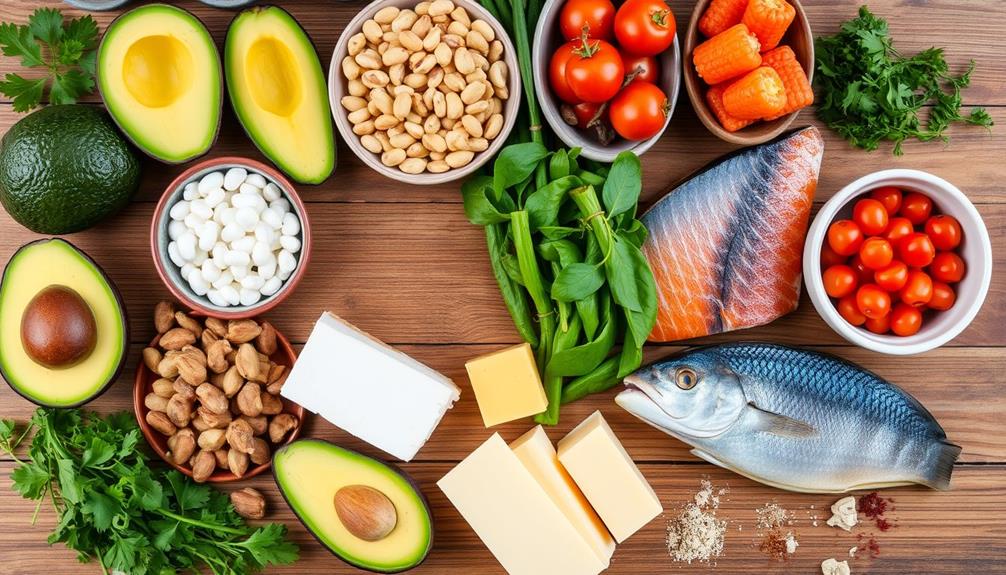
To successfully implement a ketogenic diet, knowing which foods to include is just as important as tracking your macronutrient ratios. Focus on incorporating high-quality protein sources and healthy fats while keeping carbohydrates low. Aim for about 15-20% of your total caloric intake from protein and 70-75% from healthy fats.
Here's a quick reference table for your meal plans:
| Food Group | Examples | Notes |
|---|---|---|
| Protein Sources | Grass-fed beef, fatty fish | Keep to 15-20% of calories |
| Healthy Fats | Avocados, olive oil, nuts | Should be 70-75% of calories |
| Non-Starchy Vegetables | Spinach, broccoli, zucchini | Low in carbs, high in fiber |
In addition, include low-carb dairy options like full-fat cheese, heavy cream, and unsweetened Greek yogurt, which can enrich your meals while keeping carbs minimal. Limit your total carbohydrates to less than 50 grams per day, and if you crave something sweet, opt for low-glycemic fruits like berries. By choosing these foods, you'll be well on your way to a successful and healthy keto diet.
Foods to Avoid

When diving into the keto diet, it's crucial to steer clear of high-carb foods that can throw you off track. Start by eliminating bread, pasta, rice, and sugary snacks, as these can greatly increase your carbohydrate intake and disrupt ketosis.
You'll also want to avoid starchy vegetables like potatoes, corn, and peas, which have higher carb counts compared to non-starchy options. Incorporating effective strategies for weight loss can help you stay focused on your goals.
Most fruits are off-limits, especially bananas, apples, and grapes, since they're high in sugar. However, you can indulge in low-glycemic fruits like berries in moderation.
Processed foods are another no-go; they often contain hidden sugars and carbohydrates that hinder your keto goals. Be cautious with sugary sauces, including ketchup and BBQ sauce, which can sneak extra carbs into your meals.
Lastly, keep an eye on alcohol consumption. Many beers and sweet cocktails are high in carbs, so stick to low-carb options like spirits mixed with soda water.
Meal Planning Strategies

Planning your meals strategically is essential for sticking to the keto diet and achieving your health goals. Start by focusing on high-fat foods like avocados, nuts, and fatty cuts of meat while minimizing starchy vegetables and sugars to maintain ketosis. Aim for a macronutrient ratio of around 70-75% fats, 20-25% protein, and 5-10% carbohydrates, keeping your total carbohydrate intake below 50 grams.
Utilize meal prep strategies such as batch cooking and preparing snacks in advance to make sticking to your keto meal plan easier. This helps you resist high-carb temptations. Incorporate a variety of recipes for breakfast and other meals, such as zucchini noodles or cauliflower rice, to keep your menu exciting.
Here's a simple template for your meal planning:
| Meal Type | Examples |
|---|---|
| Breakfast | Eggs with avocado |
| Lunch | Chicken salad with nuts |
| Dinner | Beef stir-fry with veggies |
Creating a shopping list based on your meal plan guarantees you have all necessary ingredients and helps you avoid impulse purchases of non-keto items. Stick to healthy foods to stay on track!
Managing Keto Flu

Many people experience what's known as keto flu when they start a ketogenic diet, facing a range of flu-like symptoms as their bodies adjust to burning fat for fuel. This adjustment period can be tough, with symptoms like fatigue, headache, and muscle cramps stemming from electrolyte imbalances and dehydration due to reduced carbohydrate intake.
To mitigate symptoms, focus on hydration by drinking plenty of water and incorporating foods high in electrolytes, such as avocados, leafy greens, and bone broth, which can also support your overall financial health by reducing potential medical costs associated with poor nutrition. These foods help replenish sodium, potassium, and magnesium, essential for maintaining balance during this phase.
Instead of abruptly cutting carbs, gradually reduce your carbohydrate intake over several days. This strategy can ease your adjustment into nutritional ketosis and lessen the severity of keto flu symptoms.
Additionally, engaging in light physical activity, like walking or yoga, can greatly boost your mood and energy levels, making the adjustment smoother.
Health Benefits and Risks
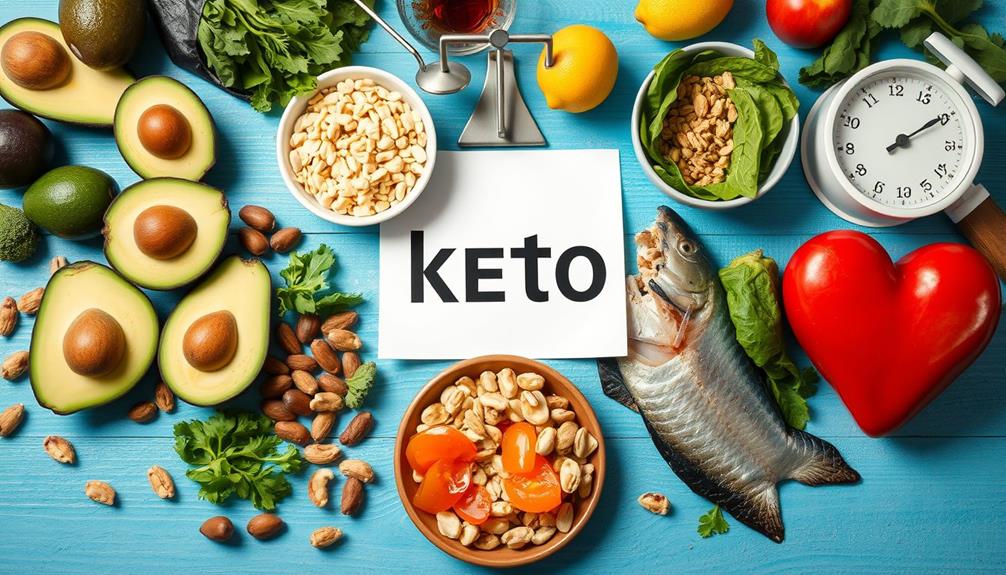
What're the health benefits and risks of adopting a ketogenic diet? This diet can lead to significant weight loss, with studies showing that you might achieve greater fat loss compared to traditional low-fat diets, especially in the first 3-6 months.
You may also experience improved glycemic control, with about 60% of type 2 diabetes patients reversing their condition through keto. Additionally, some individuals may find that their emotional well-being improves as they adopt this dietary change, reminiscent of the emotional dysregulation often seen in those with BPD.
Many find that their energy levels increase and mental clarity enhances as the brain uses ketones more efficiently than glucose.
However, there are risks to evaluate. You might experience "keto flu" during the initial adaptation phase, which can bring fatigue, headaches, and digestive issues.
Long-term adherence to the ketogenic diet can lead to increased cholesterol levels for some individuals, making regular monitoring vital. It's important to maintain open lines of communication with healthcare professionals to address any concerns and guarantee your health remains a priority.
Special Considerations

When considering the ketogenic diet, it's vital to acknowledge special circumstances that may affect its suitability for you. Certain health concerns can make this restrictive diet risky, so you should be cautious.
For instance, understanding the impact of existing health conditions on dietary choices is important, as some individuals may require alternative approaches to maintain ideal health. Here are some key considerations:
- Pregnancy and nursing may require alternative dietary approaches due to potential risks to maternal and child health.
- Individuals with high cholesterol, liver disease, kidney failure, or type 1 diabetes should avoid the keto diet, as it can exacerbate these pre-existing health conditions.
- Close monitoring of health markers, such as blood glucose and cholesterol levels, is important for those on the keto diet.
- Nutritional deficiencies can arise from the restrictive nature of the keto diet, highlighting the need for careful meal planning.
- Always consult your healthcare provider or a registered dietitian for personalized guidance before starting the keto diet.
Taking these special considerations into account can help you make informed decisions about whether the keto diet is the right choice for you.
Prioritize your health and well-being by seeking expert advice tailored to your unique situation.
Keto-Friendly Snacks
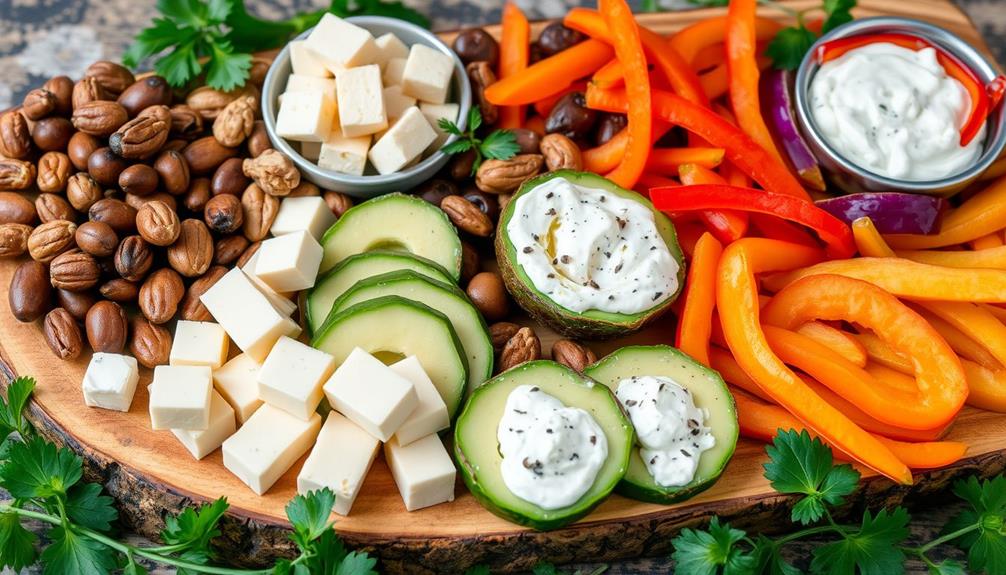
Finding keto-friendly snacks can be a game-changer when you're following a ketogenic diet. These snacks should be low in carbohydrates, ideally containing less than 5 grams of net carbs per serving, to help maintain ketosis.
You can't go wrong with hard-boiled eggs, which are packed with protein and minimal carbs. Cheese is another excellent option, rich in healthy fat and calcium, while keeping carb counts low. For additional health benefits, consider incorporating essential oils like eucalyptus oil for respiratory health, which can support overall wellness during your diet.
Consider adding nuts and seeds to your snack list as well. Macadamia nuts, for example, provide about 1.5 grams of net carbs per ounce and are a great source of healthy fat.
For a crunchy and satisfying low-carb snack, pair vegetables like celery or cucumber with high-fat dips such as guacamole or cream cheese.
If you're on the go, pre-packaged keto-friendly snacks like pork rinds or cheese crisps can be super convenient. These options typically have low carb counts, allowing you to stick to your diet effortlessly.
With these tasty choices, you'll find it easier to stay on track while enjoying satisfying snacks that align with your keto lifestyle.
Resources for Success

To succeed on your keto journey, leverage online meal planning tools that simplify your grocery shopping and meal prep.
Exploring best websites to earn money online can provide additional resources for budgeting and meal sourcing.
Joining support groups and forums can also connect you with others who share your goals, providing encouragement and tips along the way.
These resources can make a significant difference in staying committed and informed about your ketogenic lifestyle.
Online Meal Planning Tools
Online meal planning tools are invaluable resources for anyone looking to succeed on a keto diet. These tools help you track your macronutrient intake, ensuring you stick to the ketogenic ratio of 70-75% fat, 20-25% protein, and 5-10% carbohydrates.
By using online resources, you can customize your meal plan, emphasizing low-carb options that support ketosis. Additionally, exploring various coffee varieties can offer unique flavor experiences that complement your meals, especially if you enjoy a cup while preparing your dishes. For those interested in enhancing focus during meal prep, coffee's exercise benefits may be worth examining.
Here are some great options to explore:
- MyFitnessPal: Track your daily macronutrient intake effortlessly.
- KetoDietApp: Find customizable meal plans and delicious recipes.
- Ruled.me: Access meal ideas that keep your carbohydrate intake under 50 grams.
- Green Chef & Fresh n' Lean: Get pre-portioned, keto-compliant meal kits delivered to your door.
- Meal planning apps: Connect with a community for recipe sharing and motivation.
With these tools, you'll have grocery lists at your fingertips, guiding you toward keto-friendly foods while steering clear of high-carb items.
Incorporating these online meal planning resources into your keto journey can streamline your efforts, making it easier to maintain a consistent and successful diet.
Support Groups and Forums
Support groups and forums play a significant role in maintaining motivation and accountability on your keto journey. By joining online forums like Reddit's r/keto or various Facebook groups, you can engage with a vibrant community. These spaces offer shared experiences, which can inspire you to stay committed to your goals.
You'll find countless recipes, personal success stories, and meal inspiration that can make your keto diet enjoyable and sustainable. Additionally, understanding the financial considerations for elder care as you commence on this diet can help you better plan your overall health expenses.
Websites like KetoConnect and Diet Doctor feature community sections where members actively share tips and advice. You can also connect with nutrition experts through Q&A sections or live chats, gaining valuable insights into the ketogenic diet. This access to knowledgeable resources enhances your understanding of the diet and its benefits.
Additionally, consider participating in local meetups or keto workshops. These events provide face-to-face interactions, allowing you to connect with others and exchange meal ideas.
Social media platforms like Instagram and Pinterest are also treasure troves of keto influencers sharing their journeys, which can further motivate you. Engaging with these support groups and forums is essential for accountability and success on your keto journey.
Frequently Asked Questions
How Do I Make My Own Keto Diet?
To make your own keto diet, focus on high-fat foods, limit carbs to under 50 grams daily, and plan meals around protein sources. Track your intake to guarantee you meet your macronutrient goals effectively.
What Is the 80 20 Rule for Keto Diet?
You're in for a treat with the 80/20 rule! It suggests enjoying keto-friendly foods 80% of the time while allowing yourself occasional non-keto indulgences. This balance helps keep your diet enjoyable and sustainable.
What Are the 9 Rules of Keto?
You'll want to follow these nine rules of keto: limit carbs, prioritize healthy fats, moderate protein, avoid high-carb foods, focus on low-carb veggies, stay hydrated, maintain electrolytes, track your intake, and listen to your body.
What Is an Example of a Keto Meal Plan?
You might think a keto meal plan's all about deprivation, but it's actually a feast. Picture scrambled eggs with avocado, a hearty salad, and salmon with asparagus—delicious meals that keep carbs low while satisfying your cravings.
Conclusion
In your journey to design a keto diet, remember that balance is key. Just as a tightrope walker relies on focus and precision, your success hinges on mindful choices and planning. Embrace the delicious foods that fuel your body and avoid the pitfalls that could derail your progress. With dedication and the right resources, you can transform your lifestyle and reap the benefits. So, are you ready to take that leap into a healthier you?
